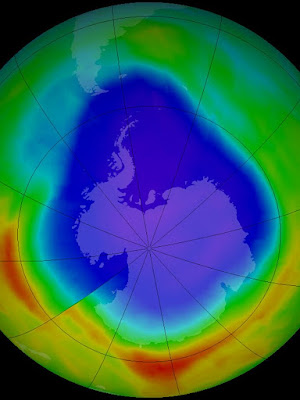The Antarctic ozone hole reached its largest size for the season on 22 September (Source: NASA/Goddard Space Flight Center)
The average size of the Earth's protective shield was 17.9 million square kilometres, according to satellite measurements by the National Oceanic and Atmospheric Administration and NASA.
"It happened to be a bit warmer this year high in the atmosphere above Antarctica, and that meant we didn't see quite as much ozone depletion as we saw last year, when it was colder," says Jim Butler of NOAA's Earth System Research Laboratory.
The Antarctic ozone hole, which forms in September and October, reached its largest size for the season - 21 million square kilometres - on 22 September.
In comparison, the largest ozone hole recorded to date was one of 29.8 million square kilometres in the year 2000.
The ozone layer - which helps protect the Earth from potentially dangerous ultraviolet rays that can cause skin cancer and cataracts - began developing holes on an annual basis starting in the 1980s due to chlorofluorocarbons, or CFCs.
CFCs, once commonly used in refrigerators and aerosol cans, now are almost non-existent thanks to an international treaty signed on 16 September 1987, amid global concern over widening holes in the ozone layer.
Still, it could take another decade before scientists detect early signs that the ozone over the Antarctic is returning, says NOAA.
The ozone layer above Antarctica likely will not return to its early 1980s state until about 2060, according to NASA scientist Paul Newman.
#
I have just been reading the article 'Chemical equator' keeps southern air clean and it got me thinking… If the atmosphere in the northern hemisphere is much more polluted than it is in the southern hemisphere why is there an ozone hole in the south and not in the north?
—Damon
The rain in Spain stays mainly on the plain' according to the classic song — but pollution doesn't.
Car exhaust fumes and ozone-depleting chemicals produced in Madrid, New York and Tokyo rise into the atmosphere, where they are swept away towards the equator and the less polluted southern hemisphere.
Luckily, most of this northern hemisphere pollution is quarantined by what scientists refer to as the chemical equator — a natural meteorological boundary in the tropics.
"At the equator, there is a lot of upward moving air and precipitation, which washes out chemicals before they can get from the northern hemisphere to the southern hemisphere," says CSIRO climatologist Dr Paul Fraser.
However, the reason we have a southern ozone hole instead of a northern one is not due to the amount of atmospheric pollution — it's due to temperature.
The stratosphere in the southern hemisphere — the layer of atmosphere where the ozone layer lies, 15 to 50 kilometres above the Earth's surface — is about five degrees Celsius colder than in the northern hemisphere.
"We get more ice in the stratosphere in the southern hemisphere, making the ozone-depleting chemicals more potent," Fraser says.
"This leads to that disparity between hemispheres as far as ozone [depletion] is concerned since it's not the level of chemicals that is driving them, but the ability of those chemicals to deplete ozone."
Chlorofluorocarbons (CFCs) are one type of ozone-depleting chemicals. They react with ultraviolet light to produce chlorine, which is then able to destroy ozone.
This chemical reaction that frees chlorine from CFCs takes place on the surface of tiny particles of ice in the stratosphere.
"The more ice there is in the stratosphere, the more ozone-destroying chlorine is liberated from CFCs," Fraser says.
A seasonal event
The ozone hole — which is not actually a 'hole' but a region of depleted ozone in the stratosphere over Antarctica — is a seasonal event.Every winter, a vortex of cold air swirls around the South Pole, forming polar stratospheric clouds.
The chemical reactions that deplete ozone take place on in these icy clouds and the 'ozone hole' begins to appear.
By late spring, when temperatures begin to rise, the ice evaporates and the ozone layer starts to recover.
The hole over Antarctica is much more pronounced than over the Arctic because the lower temperatures mean the stratospheric clouds form for longer periods.
Dr Paul Fraser was interviewed by Carmelo Amalfi.

No comments:
Post a Comment